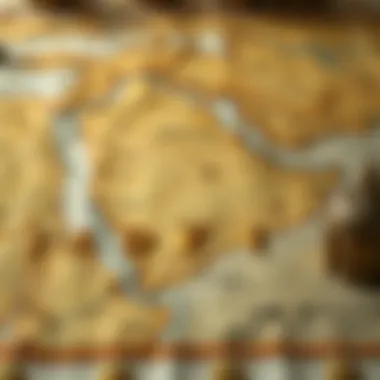Ibn Battuta's Riverland Journey: Historical and Modern Insights


Intro
The story of Ibn Battuta is one which intertwines with the cultural and geographical heritage of regions that he explored. This 14th-century Moroccan traveler not only ventured through the vast expanses of Africa but also left his mark on the Riverland. The routes he navigated are not mere depictions of movement across a map; they symbolize connections between worlds, hence fostering an understanding of historical trade, cultural exchanges, and their echo in modern scenarios.
As we unpack the significance of these journeys, we delve into how they set the stage for contemporary affairs, particularly in today's real estate market in Dubai and surrounding areas. Historical paths, while cast in the framework of the past, have uncanny ways of influencing present-day investment opportunities and trends.
In examining Ibn Battuta’s travels, we can better comprehend the geographical and cultural evolution of the Riverland, juxtaposing historical contexts with modern-day implications for investors and expatriates alike. This exploration will paint a picture of how the ramifications of his journeys extend beyond mere footnotes in history, resonating through walls of contemporary property developments and significant real estate trends.
Market Trends
When we look at the market trends today, it is imperative to reflect on the long-lasting impacts of Ibn Battuta's explorations. His traversing of various cultures and lands illuminates rich narratives that are similarly foundational to understanding the real estate dynamics in present-day Dubai.
Current Market Analysis
Real estate in Dubai is a veritable mix of high expectations and rapid transformations. Prices have fluctuated as economic factors change, yet certain constants remain. For instance, popular neighborhoods such as Downtown Dubai, fueled by an influx of expatriates, have seen continued interest. Understanding which areas maintain high demand can lead your investment decisions towards success.
- Burj Khalifa area: A hot spot attracting high-net-worth individuals.
- Dubai Marina: Boasting a vibrant lifestyle that appeals to young professionals.
- Palm Jumeirah: The symbol of luxury real estate which continues to captivate buyers.
The discerning investor must be adept at reading these trends, not merely as a peddler of property but as a strategist in a multifaceted market.
Future Projections
Looking ahead, the Dubai real estate market is on the cusp of further evolution. Given the current pace of urban development and the push for sustainability, market projections indicate a blend of opportunities and challenges.
- Continued urban expansions are likely to lead to the emergence of new residential and commercial hubs.
- A shift towards eco-friendly developments will attract investors interested in sustainable options.
- Government regulations are expected to evolve, which could affect your investment strategy significantly.
Ibn Battuta's historical routes remind us that the landscapes may change, but the essence of human endeavor remains constant, marked by growth and exploration.
Investment Opportunities
Investing in real estate is akin to embarking on a journey, one that requires foresight and understanding of the topography—both literal and metaphorical. While the historical routes of Ibn Battuta provided pathways for trade and interaction, today’s investors must navigate a different kind of landscape.
High-Growth Areas
Identifying the neighborhoods poised for growth is crucial. Areas on the fringe of established hotspots often present diamonds in the rough.
- Al Quoz: Known for its artistic vibe, projected to see a rise in demand with new investments.
- Dubai South: Positioned to benefit exponentially from ongoing infrastructural developments related to Expo 2020 and beyond.
Key Investment Strategies
Strategies should not be one-size-fits-all. Careful analysis is required to optimize return on investment.
- Diversification: Spread investments across various property types -- residential, commercial, and industrial.
- Market Timing: Understand market cycles to buy low and sell high.
- Research and Due Diligence: Leverage available resources to ensure sound investments.
By harnessing the lessons of Ibn Battuta’s travels, investors can find their own routes to success amid the contemporary real estate scene.
“The paths that connect us are often hidden beneath the sands of time, waiting to be discovered anew.”
Through this exploration of historical insight and present-day implications, both investors and researchers can uncover valuable connections that enrich their journey in the real estate landscape. For a deeper understanding, consider reading more at Britannica or Wikipedia.
Understanding Ibn Battuta’s Travels
Ibn Battuta’s journeys offer more than just tales of adventure; they present a nuanced tapestry of history that intricately links various cultures and economies. Not only does the exploration of these travels dive into the historical routes he took, it provides insight into the dynamics of trade, cultural exchange, and influence that shaped different regions—most notably the Riverland. Understanding his travels means appreciating the historical context that impacts modern life, especially in the realm of real estate and commerce.
By exploring the routes he traversed, readers can grasp the geographical layout of ancient trade networks which continue to impact today’s economic landscapes. Battuta’s legacy can still be felt as investors and business professionals look to the past for inspiration in navigating the future of the property market. In essence, gaining an understanding of his journeys allows us to decipher the intricate connections between past practices and present-day realities.
The Life and Legacy of Ibn Battuta
Ibn Battuta was born in 1304 in Tangier, Morocco. He embarked on his first major journey at the age of 20, seeking knowledge and adventure. Over a period of almost thirty years, he traveled an astonishing 75,000 miles, crisscrossing the Islamic world and beyond. His narratives reveal not just the places he visited but the richness of cultures and experiences he encountered.
His writings, compiled in "The Rihla," give voice to an era characterized by vibrant exchanges. He documented customs, traditions, and the sociopolitical environments of the lands he traversed. Battuta’s accounts are remarkable; one minute he might be describing the bustling bazaars of Baghdad, and the next, the quiet serenity of a desert oasis. This foundational work remains vital for historians, scholars, and anyone interested in understanding the complexities of 14th-century life.
Battuta’s legacy is intertwined with the concept of cultural diffusion, where ideas blend and evolve. Today's globalized world mirrors his experiences, drawing parallels between his travels and the interconnectedness we now experience thanks to modern technology and trade.
Mapping the Journey: Key Destinations
To grasp the full impact of Ibn Battuta’s travels, it’s essential to highlight some significant locations along his path.
- Tangier, Morocco: The departure point of his travels, it was here that his journey began, rich with cultural influences from Europe and Africa.
- Cairo, Egypt: A hub of knowledge, Battuta studied at al-Azhar University, immersing himself in Islamic teachings.
- Mecca, Saudi Arabia: The pinnacle of his journey was the Hajj pilgrimage, which he undertook with great devotion.
- Delhi, India: Battuta served in the court of Sultan Muhammad bin Tughlaq, expanding his experiences to the Indian subcontinent.
- Mogadishu, Somalia: Here, the richness of trade and cultural collaboration was evident, illustrating the importance of coastal trade routes.
- Timbuktu, Mali: Battuta’s visit to Timbuktu showcased the wealth and intellectual prowess of the Mali Empire, further connecting African and Islamic worlds.


This journey wasn’t just about physical distance; it was about the interactions with diverse people and cultures. Battuta’s ability to weave together these experiences reveals the significance of understanding the rhythm of ancient trade routes that echo in contemporary settings.
Ibn Battuta's legacy persists in our exploration of the Riverland and surrounding areas, providing a compass as we navigate current cultural, economic, and real estate landscapes.
"Exploration is not in seeking new landscapes, but in having new eyes." - Marcel Proust
To appreciate the nuances of today’s global market, one needs to understand its history—and here lies the core value of examining Ibn Battuta's odyssey.
The Historical Context of Riverland
The Riverland region holds a key position not only in understanding the travels of Ibn Battuta but also in appreciating the broader historical tapestry of trade, culture, and societal interactions. This area's significance is deeply rooted in its geographical features, economic activities, and the diverse cultures that have flourished along its routes. In this article, we explore how Ibn Battuta's journey through Riverland has influenced, and continues to shape, the contemporary landscapes of real estate and investment opportunities in Dubai and its vicinity.
Geographical Overview of Riverland
The Riverland area is characterized by its unique topography and strategic location that serves as a bridge between different regions, particularly linking the rich cultures and economies of Africa, Asia, and Europe. Rivers, as lifelines, have historically enabled the movement of goods and people, which aligned perfectly with Ibn Battuta’s extensive explorations. The terrain is not just picturesque; it’s also practical. The fertile banks of rivers foster agricultural activities, making it an ideal spot for settlements.
Interestingly, during the 14th century, these waterways were not simply channels of trade. They facilitated cultural exchanges, introducing new ideas, customs, and technologies that reshaped local societies. For example, traders from diverse backgrounds would often stop along these routes, leading to a fusion of culinary traditions and languages. This geographical overview highlights the immense potential of Riverland as a converging point for both historical and modern interactions—an essential factor for understanding current investment dynamics.
Cultural Interactions in Riverland
Cultural interactions in Riverland are the bedrock of its historical significance. The area was a melting pot where various ethnic groups mingled, sharing their stories, art, and commerce. Ibn Battuta's observations of different societies resonate today; his writings offer insights into the social fabrics of these regions and reveal how they adapted to one another's influences.
The impact of these interactions can still be seen in contemporary art, literature, and architecture. For instance, the blend of Islamic design with local styles has produced some stunning structures that attract expatriates and tourists alike. To illustrate, one can witness how traditional markets still celebrate this cultural mélange through vibrant displays of spices, textiles, and crafts.
Moreover, the relationships established over centuries have laid the groundwork for modern geopolitical alliances and trade agreements. Understanding these cultural dynamics not only enlightens us about past societies but also provides critical insights for investors looking to engage in the Riverland region today. The connections forged in history continue to dictate how communities evolve, which in turn affects real estate trends and local economic conditions.
"Cultural interactions are the invisible threads that weave together the fabric of society, creating a rich tapestry that is ever-evolving."
For further understanding of these intersections and their lasting impacts, resources such as Britannica and Wikipedia may provide additional insights into Ibn Battuta’s plays and Riverland’s geographical history.
Ibn Battuta’s Impact on Trade Routes
Ibn Battuta's journeys were more than just personal explorations; they fundamentally reshaped the trade connections between diverse regions. His travels serve as a historical blueprint for understanding how commerce thrived across vast distances. The effects of his explorations are embedded in the very fabric of the trade networks that flourished during and after his time. This section will investigate the significance of his impact on trade routes, detailing how establishments of links across different regions were vital for economic exchanges.
Establishing Trade Links Across Regions
The routes traversed by Ibn Battuta were a patchwork of cultural, economic, and geographical ties. Throughout his travels from Morocco through the Sahara to East Africa and Central Asia, he encountered various trading hubs that played a pivotal role in the flow of goods and ideas. For instance, upon reaching the bustling city of Timbuktu, he noted how it was not only a center for trade but also a melting pot of cultures. Merchants from disparate origins would converge, exchanging spices, textiles, and knowledge.
An interesting insight from his time in Cairo reveals how the trade dynamics operated. The city bustled with activity as traders would gather in the markets known as suqs, where bartering went hand in hand with discussions on philosophical ideas and scientific discoveries. It’s clear that these trade routes, nurtured by Ibn Battuta's detailed accounts, forged connections that went beyond mere transactions.
- Merchants from various regions: Persian traders, Arab sailors, African caravanners.
- Cultural exchanges: Language, art, and cuisine shared among diverse groups.
His travels laid down the groundwork for what we now recognize as an early form of globalization—not merely focused on trade but on the intersection of cultures that persists in today’s economies.
Economic Exchanges Influenced by Travels
As Ibn Battuta navigated various landscapes, he also documented the economic exchanges pivotal to each region's sustainability. From the Mediterranean’s vibrant marketplaces to the opulence of Indian trade ports, he observed how local economies thrived on the influx of foreign goods.
In his accounts, he often described how silk, spices, and precious metals made their way across continents, enhancing not only the wealth of specific regions but also their cultural identity. The concept of trade networks significantly expanded during his travels, creating new market dynamics where barter and currency began to blend.
Moreover, his writings hinted at the complexities and challenges within these exchanges. The issues of taxation, control by local rulers, and the fluctuating prices of goods underlined the hurdles traders faced. He even recorded instances where the same spice could be priced differently in various markets, based on supply and demand, thus illustrating the early principles of economic theory.
These important exchanges served as a reminder that behind the commodity lies a story of human interaction—one that built bridges and sometimes burned them. In today’s context, understanding these historical trade patterns can reveal a lot about contemporary market behaviors and investment strategies in the Riverland and beyond.
"Ibn Battuta’s travels narrate a tale of interconnectedness that parallels the complexities of modern trade relationships."
In this way, Ibn Battuta didn’t merely traverse routes; he brought together worlds—elements that today’s investors, brokers, and buyers can learn a great deal from.
Riverland in Contemporary Context
The Riverland region stands as a juxtaposition of historical significance and contemporary evolution. To delve into this area is to uncover layers of stories that intertwine the past with the modern-day realities of investment and growth. The routes traversed by Ibn Battuta nearly seven centuries ago have carved pathways not just for trade but have also sculpted the economic landscape we observe today. This section examines the importance of Riverland in today’s context, emphasizing modern development initiatives and real estate trends that resonate with the echoes of Battuta's adventures.
Modern Development Initiatives in Riverland
In recent years, the Riverland has seen a surge in modern development initiatives aimed at transforming the region into a pulsating hub for commerce and living. These undertakings are rooted in an understanding of the rich historical legacy while forward-looking to ensure sustainable growth. One of the notable initiatives is the Riverland Comprehensive Development Project, which seeks to blend residential, commercial, and cultural spaces.
- Urban Expansion: The urban fabric of Riverland is adapting to accommodate an increasing population and investment influx. This includes the construction of new residential complexes and the upgrading of existing infrastructures like roads and utilities.
- Cultural Centers: Development isn’t just about buildings; it’s about preserving the heritage that made this region significant. New cultural centers aim to host exhibitions and events that educate current and future generations about the historical significance of the area, effectively enriching the community’s identity.
- Eco-Friendly Practices: There is a growing trend towards sustainability. Many new projects prioritize eco-friendly practices, utilizing renewable energy sources, and considering the environmental impacts of construction. This marks a shift in the mindset of developers who acknowledge the importance of environmental stewardship.
Real Estate Trends Shaping the Area
Real estate in Riverland is shifting dynamically, reflecting broader market trends observed in Dubai and the surrounding areas. The ongoing economic revitalization has stirred interest among investors, expatriates, and locals alike, creating a vibrant property market with diverse opportunities. Some notable trends include:


- Mixed-Use Developments: There is a growing preference for living spaces that integrate work, life, and leisure. Mixed-use developments are becoming commonplace, as they offer residents the ease of access to amenities within a short distance, promoting a balanced lifestyle.
- Luxury Living Spaces: The demand for high-end properties has grown significantly, driven by affluent expatriates and global investors. Developments that provide opulent amenities and premium locations are particularly sought after, reflecting the aspirational lifestyle many are eager to embrace.
- Affordability Initiatives: In response to rising property prices, various stakeholders are focusing on affordability. Initiatives that enable first-time buyers and middle-income families to access housing are gaining traction, counterbalancing the luxury market and ensuring that the diversity of residents is preserved.
The interplay between these trends and the historical significance of the Riverland encapsulates a unique opportunity zone, pointing towards a future where the elegant charm of the past meets the vibrant pulse of modernity. As investors, brokers, and expatriates navigate this evolving landscape, they are not merely participants in the market; they are the stewards of a legacy that began with Ibn Battuta, whose travels resonate in the very soil of the land they now seek to call home.
“The legacy of Ibn Battuta is a reminder that every journey, no matter how vast, begins with a single step. In Riverland, every brick laid today carries that tradition forward into the future.”
For a comprehensive understanding of the historical context and real estate developments in Riverland, resources like Encyclopedia Britannica, Wikipedia, and Reddit can offer further insights.
Exploring Ibn Battuta's Routes in Dubai
Ibn Battuta’s travels have woven a rich tapestry through the sands of time, with Dubai sitting snugly in the midst of his historical paths. Understanding the significance of Battuta’s routes in this lively city is akin to unraveling a complex narrative that marries the past with the present. As one of the foremost explorers of the medieval era, Battuta’s connections to the Riverland bring forth layers of historical depth that hold contemporary relevance, especially in the realm of real estate and investment opportunities.
The importance of examining Ibn Battuta’s routes in Dubai lies not only in nostalgia but also in recognizing how historical pathways influence modern development. Investors and expatriates alike can draw lessons from how these ancient routes laid the foundation for trade and cultural exchange, which continues to echo through the economic landscape of today’s Dubai.
The Intersection of History and Modernity
Dubai presents a unique crossroads where history coexists with modernity. The architectural marvels that dot the skyline stand in stark contrast to the winding paths Ibn Battuta might have traversed centuries ago. Herein lies the irony: while skyscrapers shoot into the clouds, the narratives he brought forth still shape the city’s identity. The authenticity of historical trade routes extends into today’s vibrant commercial activities.
In terms of benefits for contemporary investors, recognizing this intersection is crucial. It allows them to harness the stories behind locations, giving properties a narrative that captivates potential buyers. Because of this, places along Battuta’s journey in Dubai are not just geographical points but cultural landmarks that commemorate a rich heritage. Here, potential investors can tap into a market that values not only luxury but also historical significance.
Key Landmarks Along Ibn Battuta’s Path
As it turns out, several key landmarks stand as testaments to Ibn Battuta’s journey through this area.
- Ibn Battuta Mall: Originally designed to reflect the traveler’s extensive explorations, this retail destination is more than a shopping center; it's a cultural homage. Visitors can navigate through halls that capture the essence of the countries he visited, making it a unique experience for both residents and tourists.
- The Dubai Marina: As a bustling hub, the Marina routes reflect natural waterways akin to those that Battuta would have encountered. The blending of modern living with nature invokes the historical relationship he shared with bodies of water.
- Sheikh Zayed Road: This impressive thoroughfare serves as a major artery in Dubai's economic activities, showcasing how the area's once crucial trade routes have evolved into a modern transport network.
In looking at these landmarks, it becomes apparent that they don’t merely serve modern purposes; they carry the narrative of a historic voyager. The distinct blend of past and present signifies the continuous impact of Ibn Battuta’s travels, guiding economic activity and inviting scrutiny about investment opportunities.
When considering real estate, investors should look to these areas, not just for their physical attributes but for the stories they tell. Each landmark embodies a unique opportunity where one can participate in the ongoing legacy that Ibn Battuta initiated many centuries ago. For anyone involved in the property market—be they brokers, expatriates, or buyers—the task is to uncover the narratives beneath the surface and align modern investments with historical significance.
"Understanding what came before enhances foresight on what lies ahead."
Cultural Heritage Preservation in Riverland
Cultural heritage preservation in the Riverland region stands as a vital testament to the rich tapestry of history and identity that Ibn Battuta once traversed. This preservation extends beyond mere physical structures; it embodies the values, traditions, and stories woven into the very fabric of this area. The significance of maintaining these historical sites cannot be overstated, as they offer insights into the past and serve as anchors for communal identity in today’s rapidly changing world.
Efforts to Maintain Historical Sites
Efforts to maintain historical sites in the Riverland are increasingly recognized as both a cultural responsibility and a practical necessity. Local authorities, alongside various heritage organizations, are spearheading initiatives aimed at conserving landmarks that tell the stories of earlier civilizations. Notably, these efforts encompass the restoration of ancient mosques, forts, and caravanserais that were once bustling hubs of trade and culture during Ibn Battuta's time.
One interesting approach involves utilizing modern technology. Through digital mapping and 3D modeling, heritage sites can be documented and monitored efficiently. This not only helps in the preservation but also provides valuable data for educators and researchers looking to delve into the historical aspects of the region. For instance, the restoration of the Al-Jahili Fort in nearby areas integrates such technologies, allowing a clearer picture of historical architecture to emerge.
Furthermore, resources such as UNESCO’s World Heritage Centre play a crucial role in guiding local preservation efforts. By securing funding and expert advice, regions can access support that enhances and sustains their cultural heritage initiatives.
Community Engagement in Cultural Projects
The bedrock of successful cultural heritage preservation lies in community engagement. In Riverland, local communities play an active role in protecting and promoting their heritage. Programs that involve schools, universities, and community groups help to foster a sense of pride and ownership among residents.
Workshops and cultural festivals provide platforms for sharing traditional practices, with cooking and craft demonstrations that link today's inhabitants to their ancestors. For example, it's not uncommon for families to host events showcasing traditional crafts such as pottery or weaving, which can often trace their roots back to the time of Ibn Battuta. This intergenerational knowledge transfer is crucial for keeping the culture alive and vibrant.
Moreover, local governments and NGOs facilitate volunteer projects, allowing residents to participate hands-on in the upkeep and promotion of their historical sites. This could mean anything from garden restoration at a local historical site to organizing guided tours that educate visitors about the region’s past. As residents become more involved, they forge a stronger connection with their history and develop a collective consciousness that values preservation.
Investment Opportunities in Riverland
Investment opportunities in Riverland reflect a confluence of historical richness and modern economic dynamics. This region has not only witnessed the footprints of travelers like Ibn Battuta but also stands on the brink of development and cultural resurgence. Investors, brokers, expatriates, and local buyers can align their interests with the current trends, uncovering potentials that could shape the future of both real estate and community.
The allure of Riverland lies not just in its past but also in what it holds for aspiring stakeholders. The complex interplay between cultural heritage, ongoing development initiatives, and market demand creates a fertile ground for investment. As urbanization continues to rise, the Riverland is positioning itself as a key player in the broader landscape of real estate and economic activity.
Among the essential considerations for investing in this region are:
- Heritage Significance: The historical routes that Ibn Battuta traversed play a role in shaping local identity and attracting tourism, making heritage-linked properties particularly appealing.
- Emerging Infrastructure: Ongoing and planned infrastructure projects can significantly enhance property values, connecting Riverland more effectively with metropolitan areas.
- Cultural Presence: Opportunities for cultural investments, like community-engaged projects, resonate well with state and local initiatives.
- Diverse Ecosystem: Given its geographical diversity, there's a range of property types—from residential developments to commercial spaces—that cater to varied market segments.
"Diving into investment here is not just about land and buildings; it's about becoming part of a living history."
Identifying Potential Growth Areas
Identifying growth areas within Riverland requires a strategic approach, combining both analytical assessment and local insights. A diligent review of existing developments reveals hotspots that are primed for both residential and commercial activities. For instance, initiatives to revitalize urban spaces near historical sites are drawing attention.
Key factors to consider include:
- Proximity to Urban Centers: Areas near major trade routes or urban facilities tend to attract more investments. For example, neighborhoods adjacent to existing transport projects offer enhanced accessibility.
- Government Incentives: The local government's support for real estate development, including tax incentives and grants, can provide an attractive proposition for potential investors.


Investors might also look towards areas traditionally underserved in terms of development. Investing in such zones can yield high returns as they gradually receive attention and infrastructure improvements.
Prospective Market Dynamics
The market dynamics in Riverland are quite complex, influenced by both global and local trends. On one hand, the ongoing economic transformation of the region fosters growth; on the other, fluctuation in global markets can also affect real estate prices and demand.
Noteworthy market dynamics include:
- International Interest: With increasing global investors looking toward emerging markets, Riverland's unique zest for cultural integration and modern amenities can be very appealing.
- Technological Integration: Properties with smart technology and sustainable practices are likely to attract tech-savvy buyers, enhancing their market appeal.
- Cultural Tourism: As tourism thrives, properties that are strategically located near cultural landmarks gain a competitive edge, offering both lifestyle and investment returns.
Investment in Riverland is not merely a financial decision; it's a commitment to partake in its evolving narrative—a blend of history, culture, and contemporary opportunity.
For further insights, resources like Wikipedia or Britannica provide valuable information regarding historical and current trends relevant to Riverland.
Sustainability in Real Estate Development
Sustainability has become a buzzword in today’s real estate market, especially within burgeoning areas like the Riverland. As the industry faces mounting pressure from climate change and societal expectations, the integration of eco-conscious designs and practices is no longer merely a trend, but a necessity. Real estate development in this context isn’t just about erecting buildings at a rapid pace—it's about doing so in a manner that respects and enhances the surrounding environment.
This topic significantly resonates with investors, brokers, and buyers, given the growing awareness of environmental issues and consumer preference for sustainable options. Incorporating sustainability into real estate development isn’t only beneficial for the planet; it often leads to increased property values and improved community relations. More potential buyers are inclined to choose properties that offer modern, eco-friendly amenities and are designed with sustainability in mind.
Incorporating Eco-Friendly Practices
When we talk about eco-friendly practices in real estate development, we are referring to a range of strategies that prioritize environmental health and resource efficiency.
Some notable elements include:
- Energy Efficiency: Utilizing energy-efficient materials and technologies such as solar panels, smart thermostats, and high-efficiency appliances can significantly reduce a building’s carbon footprint.
- Water Conservation: Implementing systems like rainwater harvesting or greywater recycling can minimize water wastage. Simple practices such as using drought-resistant landscaping can make a big difference in arid regions more prone to water scarcity.
- Sustainable Materials: Sourcing materials that are recycled or sustainably harvested ensures lower environmental impact. For example, bamboo and reclaimed wood are gaining popularity due to their low ecological cost.
These eco-friendly practices not only contribute to a healthier planet but also appeal to a demographic that increasingly values sustainability. A report by the World Green Building Council suggests that green buildings can reduce operating costs while increasing asset value, making sustainability a wise financial move as well.
Balancing Growth with Environmental Concerns
Finding the right balance between rapid urban development and environmental responsibility is a challenge for modern real estate developers. It’s a bit like walking a tightrope; one side leans towards unchecked growth while the other tilts toward a stagnated, overly cautious approach.
Key considerations include:
- Regulatory Frameworks: Various governments now impose regulations aimed at minimizing environmental impact. Developers must navigate these rules while still pursuing growth opportunities.
- Community Engagement: Involving the local community in the planning stages can ensure that developments meet residents' needs while also considering environmental impacts. Listening to community concerns may reveal innovative solutions that align development goals with ecological sustainability.
- Long-term Vision: Developers should embrace a long-term perspective rather than focusing solely on short-term gains. Projects that are built to last while taking sustainability into account can thrive in the marketplace for years to come.
To wrap it up, the conversation around sustainability in real estate development is steadily gaining momentum. Stakeholders need to acknowledge its importance in shaping not just the Riverland but also the global landscape. As history teaches us, the paths we choose today shape the journeys of tomorrow.
Political and Economic Influences
The political and economic landscapes play a crucial role in shaping the dynamics of any region, and Riverland is no exception. Understanding these influences not only provides insight into the historical context of Ibn Battuta's travels but also sheds light on the contemporary real estate and investment scenarios in the area. As we navigate through these facets, it's clear how deeply intertwined politics and economics are with the developmental narrative of Riverland.
Regional Stability and Investment Climate
When discussing investment, the first thing that springs to mind is stability. A stable political atmosphere is akin to a warm blanket in a stormy night for investors. They prefer regions where the risk is minimized and the environment is conducive to growth.
In Riverland, several factors contribute to the overall investment climate:
- Political Stability: A government that remains secure encourages businesses to flourish. Without the threat of upheaval, companies and investors feel more secure in their investments.
- Economic Policies: Favorable policies that support businesses—such as tax incentives and streamlined regulations—can draw in foreign investment. It’s like rolling out the red carpet for international investors who are eager to establish a foothold in a promising market.
- Infrastructure Development: Investments in roads, public transportation, and communication networks can amplify the attractiveness of a region. This infrastructure not only enhances quality of life but also fosters economic activities, making it an idyllic destination for real estate investment.
Moreover, Riverland's ongoing development initiatives bolster confidence among stakeholders. For instance, organizations often evaluate the S&P Stability Index to gauge market resilience. As the local government prioritizes long-term projects, it signals a clear path for continued growth.
"Investment thrives where peace prevails; the clarity of a stable environment often outweighs short-term blunders."
Government Policies Affecting Real Estate
In the sphere of real estate, government policies can make or break the dream of ownership or investment. In Riverland, these policies are crucial and can be broken down into several components that shape the property market:
- Zoning Laws: These dictate what can be built where and significantly affect property values. Restrictions can lead to scarcity, thereby driving prices up—it's supply and demand, plain and simple.
- Financing Programs: Access to loans and favorable interest rates enables more buyers to enter the market. Without affordable financing, many potential homeowners remain on the sidelines, limiting market growth.
- Tax Benefits: Various incentives—like property tax exemptions or reduced rates for first-time buyers—have a tangible impact on buying behavior. Governments that understand the pulse of their residents can create frameworks that facilitate transactions rather than hinder them.
- Sustainability Initiatives: As environmental concerns grow, policies supporting green building practices encourage eco-conscious developers. This innovation aligns with global trends and can draw a niche market interested in sustainable living.
Investors and buyers should stay abreast of local and national policy changes as they can shift the landscape remarkably. With policies that aim to retain stability while promoting growth, Riverland can serve as an appealing target for those interested in tapping into its property market. Keeping an eye on these evolving aspects is essential for making informed decisions.
Culmination: The Enduring Legacy of Ibn Battuta
Ibn Battuta stands as a towering figure in the annals of exploration, with his journeys remarkably shaping our understanding of not only the pathways he traversed but also the cultural and economic exchanges that ensued. His legacy resonates today, especially in the Riverland, where ancient routes have evolved into a thriving nexus for trade and real estate. This section aims to underline the importance of Ibn Battuta’s contributions and the enduring impact he has had on contemporary society.
His travels provided vital insights into the interconnectedness of societies. The narratives he left behind reveal much about the customs, traditions, and economies of the regions he explored. Exploring these narratives allows us to appreciate the past intricacies of trade relations and cultural exchanges that laid the groundwork for modern interactions. Furthermore, his detailed accounts serve as historical landmarks, guiding not only researchers but also investors and expatriates interested in tapping into the rich tapestry of Riverland’s past.
The significance of Ibn Battuta’s journeys cannot be overstated, particularly when considering the implications for contemporary investment opportunities. Investors seeking viable areas for development can look to historical routes mapped out by Battuta. His journey highlights how certain pathways opened new frontiers, illustrating how history can guide modern economic ventures.
Moreover, engaging with Battuta's legacy enriches our understanding of cultural preservation. The preservation of historical sites tied to his legacy fosters community pride and engagement. This deep-rooted appreciation for cultural heritage can drive tourism, capturing the interest of those who wish to explore the Riverland not just for its economic potential but for its rich history.
"Balancing the echoes of the past with the pulse of the present is where true progress lies."
Thus, it becomes clear that Ibn Battuta's impact extends beyond his time. His journeys provide a panoramic view of human connection, urging contemporary stakeholders to appreciate the layers behind physical spaces. They are more than mere geographical landmarks; they are conduits of history, opening doors to economic, cultural, and social opportunities. As we move to explore the future prospects for the Riverland, one must carry forward the lessons gleaned from Ibn Battuta's remarkable voyages.







